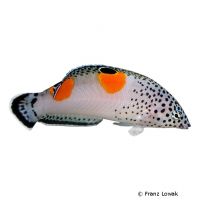Clown Coris juvenile (Coris aygula)
| Clown Coris juvenile Coris aygula | |
|---|---|
| Name | Clown Coris juvenile |
| Name Lat. | Coris aygula |
| Family | Wrasses |
| Family lat. | Labridae |
| Order | Wrasses & Relatives |
| Order lat. | Labriformes |
| Origin | Indo-West Pacific, Red Sea |
| Habitat | Lagoons, seaward reefs |
| Diet | Carnivore |
| pH | 8,1-8,4 |
| Hardness | 8-10 °KH |
| Behavior | Aggressive |
| Keeping | Individual |
| Reef Compatible | With caution |
| Care Level | Difficult |
| Life Span | N/A |
| Protection | No |
| Metric Units | |
| Size | 120 cm |
| Temperature | 22-28 °C |
| Salinity | 33-36 ‰ |
| Aquarium | ~ 4.500 l |
| US Units | |
| Size | 47" |
| Temperature | 72-82 °F |
| Salinity | 1.020-1.025 sg |
| Aquarium | ~ 1,100 gal |
Distribution and habitat
The distribution area of Coris aygula is the Indian Ocean and the Red Sea as well as the western Pacific Ocean from the east coast of Africa via Indonesia to Japan and Australia. There they live in lagoons and on outer reefs near sandy bottoms and coral rubble up to 30 m depth.
Maintenance
They need a well-structured aquarium with plenty of swimming space and a reef structure (hiding and covering possibilities) with living stones that act like a biological filter and whose growth they can graze on, as well as sandy areas of fine, at least 20 cm deep sand (no coral rubble!). Only calcareous, heavy metal-free sands, gravels, stones or sea sand may be used
Filters, skimmers and heaters are necessary to ensure water quality, as well as pumps to simulate tides, swells and bottom currents. Lighting must be appropriate for the species' day-night rhythm
| Salinity: 33-36 ‰ | pH value: 8.1-8.4 |
| Carbonate hardness: 8-10 °KH | Nitrate content: 2-8 mg/l |
| phosphate content: 0.01-0.1 mg/l | nitrite content: 0.0-0.05 mg/l |
For salinity, an average value should be aimed for, which may only vary slightly by +/- 0.5 ‰. Ammonia and ammonium must not be measurable. Special attention must be paid to constantly good water quality.
Diet
They feed on small crustaceans and mollusks. The food change does not always succeed without problems. The food supply should consist of a combination of chopped shrimp, mussel and crab meat with live and frozen food such as mysis, krill, artemia and shrimp or a frozen food mixture enriched with vitamins. High-quality flake and granulated food is also often accepted after a period of acclimation. It is recommended to feed small portions several times a day, this reduces intra-species aggression and protects lower animals in the aquarium
Regular and varied feeding promotes health and increases resistance.
Behaviour and compatibility
Juvenile animals can be kept in a group. Adult animals live solitary and behave very aggressive within the species. Towards other not too small fish they behave peacefully.
Sex dimorphism
They are protogynous hermaphrodites, meaning that most males develop from functional females. Males grow a bump on their forehead and have an elongated first dorsal fin ray.
Reproduction and breeding
There are no known reports of successful breeding in the aquarium.
Important
Their color dress varies greatly depending on age. Adults are blue-green with a white or light green stripe around the middle of the body. When threatened, they sometimes bury themselves in the sandy substrate
As reef dwellers, they should be kept together with corals and not in a fish-only aquarium. With sufficient and varied feeding, which also reduces aggressiveness, they can be kept well with invertebrates (corals), only tubeworms, snails, crabs, etc. should be kept with caution
If different species are kept together, care should be taken to ensure that the fish match each other in terms of water quality and temperature requirements and social behavior, and that the setup meets the needs of all species kept together. New fish to be introduced must be acclimated slowly to the water in the aquarium
Further literature can be found in your pet store.
References
Text: Werner Winter; Image: Franz Lowak
Source: KUITER, DEBELIUS (2007): Atlas der Meeresfische: Die Fische an den Küsten der Weltmeere, Kosmos Verlag; BAENSCH & DEBELIUS (2006): Meerwasser Atlas Bd. 1, Mergus Verlag; ENGELMANN (2005): Zootierhaltung - Tiere in menschlicher Obhut: Fische, Verlag Harri Deutsch
- Gemäß § 21 Abs. 5 Tierschutzgesetz idgF
